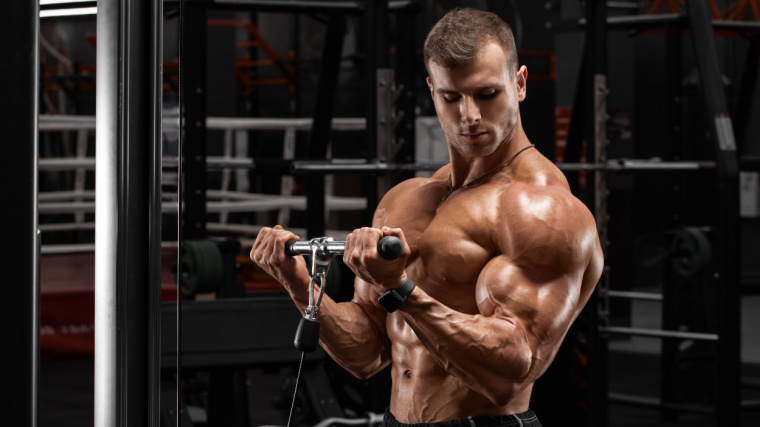Muscle Insider
New member
John “the Mountain Dog” Meadows passed away on Aug. 8, 2021. He was 49 years old. Meadows’ death sent ripples around the globe as the bodybuilding community at large mourned the passing of a titan. Meadows, both a competitor and coach, built his reputation upon two pillars: He was uncommonly kind-hearted and knew a ton about building muscle....
The post Mountain Dog Training: Understanding John Meadows’ Philosophy for Maximum Muscle Growth appeared first on BarBend.
John “the Mountain Dog” Meadows passed away on Aug. 8, 2021. He was 49 years old. Meadows’ death sent ripples around the globe as the bodybuilding community at large mourned the passing of a titan. Meadows, both a competitor and coach, built his reputation upon two pillars:
He was uncommonly kind-hearted and knew a ton about building muscle. Like, a scary amount. Meadows’ own philosophy for hypertrophy training, appropriately dubbed Mountain Dog training, deservedly remains a popular approach to designing bodybuilding workouts for both rank beginners and IFBB pros alike.
 Credit: Nikolas_jkd / Shutterstock
Credit: Nikolas_jkd / Shutterstock
[Read More: The 15 Best Shoulder Exercises For Building Muscle]
If you want to take your physique to the next level, consider taking a page from the Dog’s playbook. Along with the advice and insight from Theresa Ivancik, an IFBB Pro League women’s bodybuilder and Olympia veteran who trained under Meadows, here’s how to train like a real Mountain Dog.
What Is Mountain Dog Training?
Every professional physique coach has their own branded approach to building muscle, from Dante Trudel’s DoggCrapp Training to Hany Rambod’s FST-7 system. While Meadows did (and does) offer specific workout plans on his website tailored to particular fitness goals, the Mountain Dog method is more of a philosophy than something you can map out on a spreadsheet.
How It Works
In an Aug. 28, 2020 YouTube video, Meadows sat down to explicate on his workout philosophy in detail. Put simply, the Mountain Dog method involves segmenting a gym session into four distinct phases:
This is where Meadows’ own perspective differed from many other successful bodybuilders. Instead of pursuing one zenith of bodybuilding training — think Dorian Yates’ patented high-intensity, low-volume Blood and Guts workouts — Meadows borrowed from several ideologies and put them together in a specific order.
https://www.youtube.com/watch?v=wXCU4vKefCcVideo can’t be loaded because JavaScript is disabled: What is "Mountain Dog Training" and WHY IT WORKS (https://www.youtube.com/watch?v=wXCU4vKefCc)
I still use these methods today. Working with John took my bodybuilding career to a completley different level.
Theresa Ivancik, IFBB Pro League Bodybuilder[/quote]
A Mountain Dog workout has four distinct phases, each with its own goal. You begin with some pre-activation work, move on to high-intensity power output movement, and then chase a gnarly pump before capping things off with a couple rounds of not-so-comfortable stretching.
Four Phases of Mountain Dog Training
If you’re a bodybuilding aficionado already, the Mountain Dog workout program may look somewhat familiar to you. Modern bodybuilding training has moved past the Golden Era days of three-hour pump fests, thanks partly to coaches like Meadows.
Here’s how Meadows explains the four phases of Mountain Dog, and what the scientific literature has to say about them.
Phase 1: Pre-Pump Activation
The first phase, as Meadows calls it, is for “pre-pump activation.” In short, this phase of the workout is meant to bridge the gap between your generalized warm-up and some of the heavier lifting to follow.
 Credit: ALL best fitness is HERE / Shutterstock
Credit: ALL best fitness is HERE / Shutterstock
[Read More: Romanian Deadlift Vs. Deadlift — Which is Better for Your Program?]
For this phase, you should pick one exercise for the body part you’re training on a given day that meets the following criteria:
[*]Is easy on your joints or connective tissues
[*]Doesn’t have a complicated technique
[*]Can help you establish a solid mind-muscle connection with the target muscle
Meadows suggests performing sets of 8 to 12 reps with a moderate weight and to steer clear of any fancy bodybuilding training techniques like drop sets or rest-pause work. This first phase is all about setting you up for success on the movements that follow.
There’s some scientific credibility to pre-activation work. Some data show that establishing a better mind-muscle connection, which is only doable if you aren’t working at ultra-high intensities, can improve your technique and increase muscular activation overall. (1)(2)
From the Pro: Ivancik says her sessions with Meadows always began with an “activation” set. “This really helped eliminate the other body parts that would kick in if you started to fatigue out,” she wrote to BarBend over email.
Phase 2: Explosive
After priming your body for performance with phase one, the second phase of a Mountain Dog bodybuilding workout is all about power. The “Explosive” phase, as Meadows calls it, is where you’ll perform the heaviest and hardest lifts of the workout.
 Credit: Improvisor / Shutterstock
Credit: Improvisor / Shutterstock
[Read More: What Are Workout Splits and Which Is the Best One?]
The premises here are simple and remarkably akin to many of the working philosophies of powerbuilding. When selecting and performing one or two exercises for this phase, you should:
[*]Strive for high-intensity sets, as long as you can maintain impeccable form.
[*]Use multi-joint compound exercises and track some form of progressive overload on a session-by-session basis.
[*]Strive to lift explosively while maintaining robust control during the eccentric phase of each repetition.
Meadows stresses that you should go hard on your movements of choice in this phase, but should leave one rep in the tank no matter what on your top sets. He remarks that this phase is all about stimulating those Type-II, fast-twitch muscle fibers, which some data have shown to contain the most potential for hypertrophy. (3)
From the Pro: “Meadows was famous for using working sets of 10 until you got to the weight that was hard to use,” Ivancik writes. “Sometimes these methods would go to failure or have you leaving two more reps in the tank.”
Phase 3: Supramaximal Pump
The third phase of Mountain Dog training for muscle growth is what Meadows dubs the “supramaximal pump” phase, and it’s exactly what it sounds like. After establishing a good mind-muscle connection during your warm-up and pushing intensity through the roof in Phase 2, Phase 3 is all about forcing as much blood into the target muscle as you can.
[*]Lean on high-intensity bodybuilding training techniques like drop sets, forced reps, partials, cluster sets, and so on.
[*]Do not use compound exercises; go for single-joint isolation moves instead.
Meadows notes that you should only need one set during this phase if you select an appropriate movement and commit to pushing yourself as hard as you can.
From the Pro: “Since you can’t really get the full squeeze and holds when you are power training, this method allows you to do so. Lighter weight gives you better control of the muscle to do the fine-tuning work”, Ivancik advises.
Phase 4: High-Intensity Stretching
Meadows caps off his Mountain Dog philosophy by ending his workouts with a bout of high-intensity stretching. The premise here is simple: Select a lightly-loaded exercise that stretches the target muscle under load (think the bottom of a dumbbell flye for your pecs) and hold it for time.
[*]Hold the stretched position for 30 to 60 seconds for one to three rounds.
There’s some very limited but compelling evidence that intense stretching protocols can augment muscle growth. (4) Broader research, though, has shown that loading the lengthened position of a muscle, rather than its most contracted position, to be an extremely potent muscle-growing stimulus. (5)
From the Pro: Anecdotally, Ivancik has felt and seen good results using this approach. “This [stretching] helps lengthen the muscle tissue, allows room for blood flow, assists in muscle growth, and helps decrease muscle soreness,” she writes.
Sample Mountain Dog Training Workout & Thoughts From an IFBB Pro
Meadows undeniably had his ducks in a row when it came to bodybuilding training, but an array of principles aren’t as easy to visualize as something you can see on a spreadsheet. Luckily, some expert input goes a long way. Here’s a sneak peek into one of Meadows’ hand-crafted workouts and a very credible testimonial to its efficacy as well:
The Workout
There’s no single workout plan that emblematizes the Mountain Dog training style. Meadows took his decades of experience in the sport and coalesced a training philosophy that he applied to a wide array of different individual programs.
 Credit: YAKOBCHUK VIACHESLAV / Shutterstock
Credit: YAKOBCHUK VIACHESLAV / Shutterstock
[Read More: 5 Bench Press Programs to Build a Bigger, Stronger Chest]
Here’s a sample push workout from one of Meadows’ programs that can help you understand the ideas of Mountain Dog in action:
About the Expert
Theresa Ivancik is a veteran of the physique game and a former client and personal friend of Meadows’. With a laundry list of bodybuilding shows to her name, including a stellar 7th-place finish at the 2022 Olympia, Ivancik knows a thing or two about the Mountain Dog methodology.
View this post on Instagram A post shared by Theresa Ivancik IFBB PRO (@tivancik_ifbbpro)
(@tivancik_ifbbpro)
[/quote]
Meadows’ methods have always made very good logical sense. Working with John took my bodybuilding career to a completely different level. His style was very effective for me both as an athlete and a coach myself.
Theresa Ivancik, IFBB Pro League Bodybuilder[/quote]
Your Takeaways
John Meadows was a coach, competitor, educator, and innovator. His patented Mountain Dog training style not only relied upon sound science, but also mixed in years of in-the-gym experience to create a versatile and effective approach to muscle growth.
More Training Content
References
[*](2013). Attentional focus and motor learning: A review of 15 years. International Review of Sport and Exercise Psychology. 6. 77-104. 10.1080/1750984X.2012.723728.
[*]Schoenfeld, B. J., Vigotsky, A., Contreras, B., Golden, S., Alto, A., Larson, R., Winkelman, N., & Paoli, A. (2018). Differential effects of attentional focus strategies during long-term resistance training. European journal of sport science, 18(5), 705–712.
[*]van Wessel T, de Haan A, van der Laarse WJ, Jaspers RT. The muscle fiber type-fiber size paradox: hypertrophy or oxidative metabolism? Eur J Appl Physiol. 2010 Nov;110(4):665-94. doi: 10.1007/s00421-010-1545-0. Epub 2010 Jul 3. PMID: 20602111; PMCID: PMC2957584.
[*]Warneke, K., Brinkmann, A., Hillebrecht, M., & Schiemann, S. (2022). Influence of Long-Lasting Static Stretching on Maximal Strength, Muscle Thickness and Flexibility. Frontiers in physiology, 13, 878955.
[*]Pedrosa, G. F., Lima, F. V., Schoenfeld, B. J., Lacerda, L. T., Simões, M. G., Pereira, M. R., Diniz, R. C. R., & Chagas, M. H. (2022). Partial range of motion training elicits favorable improvements in muscular adaptations when carried out at long muscle lengths. European journal of sport science, 22(8), 1250–1260.
Featured Image: Nikolas_jkd / Shutterstock
The post Mountain Dog Training: Understanding John Meadows’ Philosophy for Maximum Muscle Growth appeared first on BarBend.
Click here to view the article.
The post Mountain Dog Training: Understanding John Meadows’ Philosophy for Maximum Muscle Growth appeared first on BarBend.
John “the Mountain Dog” Meadows passed away on Aug. 8, 2021. He was 49 years old. Meadows’ death sent ripples around the globe as the bodybuilding community at large mourned the passing of a titan. Meadows, both a competitor and coach, built his reputation upon two pillars:
He was uncommonly kind-hearted and knew a ton about building muscle. Like, a scary amount. Meadows’ own philosophy for hypertrophy training, appropriately dubbed Mountain Dog training, deservedly remains a popular approach to designing bodybuilding workouts for both rank beginners and IFBB pros alike.

[Read More: The 15 Best Shoulder Exercises For Building Muscle]
If you want to take your physique to the next level, consider taking a page from the Dog’s playbook. Along with the advice and insight from Theresa Ivancik, an IFBB Pro League women’s bodybuilder and Olympia veteran who trained under Meadows, here’s how to train like a real Mountain Dog.
What Is Mountain Dog Training?
Every professional physique coach has their own branded approach to building muscle, from Dante Trudel’s DoggCrapp Training to Hany Rambod’s FST-7 system. While Meadows did (and does) offer specific workout plans on his website tailored to particular fitness goals, the Mountain Dog method is more of a philosophy than something you can map out on a spreadsheet.
How It Works
In an Aug. 28, 2020 YouTube video, Meadows sat down to explicate on his workout philosophy in detail. Put simply, the Mountain Dog method involves segmenting a gym session into four distinct phases:
- Pre-Pump Activation
- Explosive
- Supramaximal Pump
- High-Intensity Stretching
This is where Meadows’ own perspective differed from many other successful bodybuilders. Instead of pursuing one zenith of bodybuilding training — think Dorian Yates’ patented high-intensity, low-volume Blood and Guts workouts — Meadows borrowed from several ideologies and put them together in a specific order.
https://www.youtube.com/watch?v=wXCU4vKefCcVideo can’t be loaded because JavaScript is disabled: What is "Mountain Dog Training" and WHY IT WORKS (https://www.youtube.com/watch?v=wXCU4vKefCc)
I still use these methods today. Working with John took my bodybuilding career to a completley different level.
Theresa Ivancik, IFBB Pro League Bodybuilder[/quote]
A Mountain Dog workout has four distinct phases, each with its own goal. You begin with some pre-activation work, move on to high-intensity power output movement, and then chase a gnarly pump before capping things off with a couple rounds of not-so-comfortable stretching.
Four Phases of Mountain Dog Training
If you’re a bodybuilding aficionado already, the Mountain Dog workout program may look somewhat familiar to you. Modern bodybuilding training has moved past the Golden Era days of three-hour pump fests, thanks partly to coaches like Meadows.
Here’s how Meadows explains the four phases of Mountain Dog, and what the scientific literature has to say about them.
Phase 1: Pre-Pump Activation
The first phase, as Meadows calls it, is for “pre-pump activation.” In short, this phase of the workout is meant to bridge the gap between your generalized warm-up and some of the heavier lifting to follow.

[Read More: Romanian Deadlift Vs. Deadlift — Which is Better for Your Program?]
For this phase, you should pick one exercise for the body part you’re training on a given day that meets the following criteria:
[*]Is easy on your joints or connective tissues
[*]Doesn’t have a complicated technique
[*]Can help you establish a solid mind-muscle connection with the target muscle
Meadows suggests performing sets of 8 to 12 reps with a moderate weight and to steer clear of any fancy bodybuilding training techniques like drop sets or rest-pause work. This first phase is all about setting you up for success on the movements that follow.
There’s some scientific credibility to pre-activation work. Some data show that establishing a better mind-muscle connection, which is only doable if you aren’t working at ultra-high intensities, can improve your technique and increase muscular activation overall. (1)(2)
From the Pro: Ivancik says her sessions with Meadows always began with an “activation” set. “This really helped eliminate the other body parts that would kick in if you started to fatigue out,” she wrote to BarBend over email.
Phase 2: Explosive
After priming your body for performance with phase one, the second phase of a Mountain Dog bodybuilding workout is all about power. The “Explosive” phase, as Meadows calls it, is where you’ll perform the heaviest and hardest lifts of the workout.

[Read More: What Are Workout Splits and Which Is the Best One?]
The premises here are simple and remarkably akin to many of the working philosophies of powerbuilding. When selecting and performing one or two exercises for this phase, you should:
[*]Strive for high-intensity sets, as long as you can maintain impeccable form.
[*]Use multi-joint compound exercises and track some form of progressive overload on a session-by-session basis.
[*]Strive to lift explosively while maintaining robust control during the eccentric phase of each repetition.
Meadows stresses that you should go hard on your movements of choice in this phase, but should leave one rep in the tank no matter what on your top sets. He remarks that this phase is all about stimulating those Type-II, fast-twitch muscle fibers, which some data have shown to contain the most potential for hypertrophy. (3)
From the Pro: “Meadows was famous for using working sets of 10 until you got to the weight that was hard to use,” Ivancik writes. “Sometimes these methods would go to failure or have you leaving two more reps in the tank.”
Phase 3: Supramaximal Pump
The third phase of Mountain Dog training for muscle growth is what Meadows dubs the “supramaximal pump” phase, and it’s exactly what it sounds like. After establishing a good mind-muscle connection during your warm-up and pushing intensity through the roof in Phase 2, Phase 3 is all about forcing as much blood into the target muscle as you can.
[*]Lean on high-intensity bodybuilding training techniques like drop sets, forced reps, partials, cluster sets, and so on.
[*]Do not use compound exercises; go for single-joint isolation moves instead.
Meadows notes that you should only need one set during this phase if you select an appropriate movement and commit to pushing yourself as hard as you can.
From the Pro: “Since you can’t really get the full squeeze and holds when you are power training, this method allows you to do so. Lighter weight gives you better control of the muscle to do the fine-tuning work”, Ivancik advises.
Phase 4: High-Intensity Stretching
Meadows caps off his Mountain Dog philosophy by ending his workouts with a bout of high-intensity stretching. The premise here is simple: Select a lightly-loaded exercise that stretches the target muscle under load (think the bottom of a dumbbell flye for your pecs) and hold it for time.
[*]Hold the stretched position for 30 to 60 seconds for one to three rounds.
There’s some very limited but compelling evidence that intense stretching protocols can augment muscle growth. (4) Broader research, though, has shown that loading the lengthened position of a muscle, rather than its most contracted position, to be an extremely potent muscle-growing stimulus. (5)
From the Pro: Anecdotally, Ivancik has felt and seen good results using this approach. “This [stretching] helps lengthen the muscle tissue, allows room for blood flow, assists in muscle growth, and helps decrease muscle soreness,” she writes.
Sample Mountain Dog Training Workout & Thoughts From an IFBB Pro
Meadows undeniably had his ducks in a row when it came to bodybuilding training, but an array of principles aren’t as easy to visualize as something you can see on a spreadsheet. Luckily, some expert input goes a long way. Here’s a sneak peek into one of Meadows’ hand-crafted workouts and a very credible testimonial to its efficacy as well:
The Workout
There’s no single workout plan that emblematizes the Mountain Dog training style. Meadows took his decades of experience in the sport and coalesced a training philosophy that he applied to a wide array of different individual programs.

[Read More: 5 Bench Press Programs to Build a Bigger, Stronger Chest]
Here’s a sample push workout from one of Meadows’ programs that can help you understand the ideas of Mountain Dog in action:
- Incline Dumbbell Bench Press: 4-5 high-rep warm-up sets, then 2 working sets of 8 reps
- Incline Bench Press: 2 working sets of 8-12 reps
- Machine Chest Press: 1 extended rest-pause set
- Deficit Push-Up: 2 sets to failure
- Rear Delt Flye: 3 x 20
- Dumbbell Y Raise: 3 x 12
- Banded Spider Crawl: 3 rounds
- Dumbbell Triceps Kickback: 4×10
- Rope Triceps Extension: 4 x 12
About the Expert
Theresa Ivancik is a veteran of the physique game and a former client and personal friend of Meadows’. With a laundry list of bodybuilding shows to her name, including a stellar 7th-place finish at the 2022 Olympia, Ivancik knows a thing or two about the Mountain Dog methodology.
View this post on Instagram A post shared by Theresa Ivancik IFBB PRO
 (@tivancik_ifbbpro)
(@tivancik_ifbbpro)[/quote]
Meadows’ methods have always made very good logical sense. Working with John took my bodybuilding career to a completely different level. His style was very effective for me both as an athlete and a coach myself.
Theresa Ivancik, IFBB Pro League Bodybuilder[/quote]
Your Takeaways
John Meadows was a coach, competitor, educator, and innovator. His patented Mountain Dog training style not only relied upon sound science, but also mixed in years of in-the-gym experience to create a versatile and effective approach to muscle growth.
- Mountain Dog training is all about creating the most muscular hypertrophy possible.
- Each Mountain Dog workout contains different phases, each with their unique goals.
- A combination of pre-activation moves, high-power compound lifting, some pump work, and selective bouts of loaded stretching all contribute to the Mountain Dog philosophy.
More Training Content
- Doggcrapp Training Explained: How To Do It and What You Should Know
- Should You Try the 75 Hard Challenge? Here Are the Pros and Cons
- The Ultimate 10-Week Powerbuilding Workout Routine for Mass and Strength
References
[*](2013). Attentional focus and motor learning: A review of 15 years. International Review of Sport and Exercise Psychology. 6. 77-104. 10.1080/1750984X.2012.723728.
[*]Schoenfeld, B. J., Vigotsky, A., Contreras, B., Golden, S., Alto, A., Larson, R., Winkelman, N., & Paoli, A. (2018). Differential effects of attentional focus strategies during long-term resistance training. European journal of sport science, 18(5), 705–712.
[*]van Wessel T, de Haan A, van der Laarse WJ, Jaspers RT. The muscle fiber type-fiber size paradox: hypertrophy or oxidative metabolism? Eur J Appl Physiol. 2010 Nov;110(4):665-94. doi: 10.1007/s00421-010-1545-0. Epub 2010 Jul 3. PMID: 20602111; PMCID: PMC2957584.
[*]Warneke, K., Brinkmann, A., Hillebrecht, M., & Schiemann, S. (2022). Influence of Long-Lasting Static Stretching on Maximal Strength, Muscle Thickness and Flexibility. Frontiers in physiology, 13, 878955.
[*]Pedrosa, G. F., Lima, F. V., Schoenfeld, B. J., Lacerda, L. T., Simões, M. G., Pereira, M. R., Diniz, R. C. R., & Chagas, M. H. (2022). Partial range of motion training elicits favorable improvements in muscular adaptations when carried out at long muscle lengths. European journal of sport science, 22(8), 1250–1260.
Featured Image: Nikolas_jkd / Shutterstock
The post Mountain Dog Training: Understanding John Meadows’ Philosophy for Maximum Muscle Growth appeared first on BarBend.
Click here to view the article.

